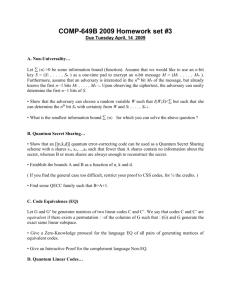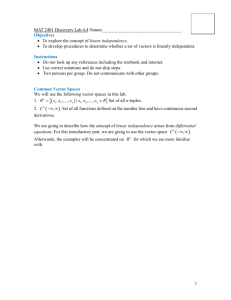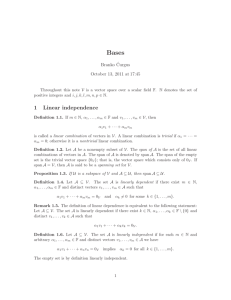Lecture 3: Steinitz exchange and bases Recall the intuition that a set
advertisement
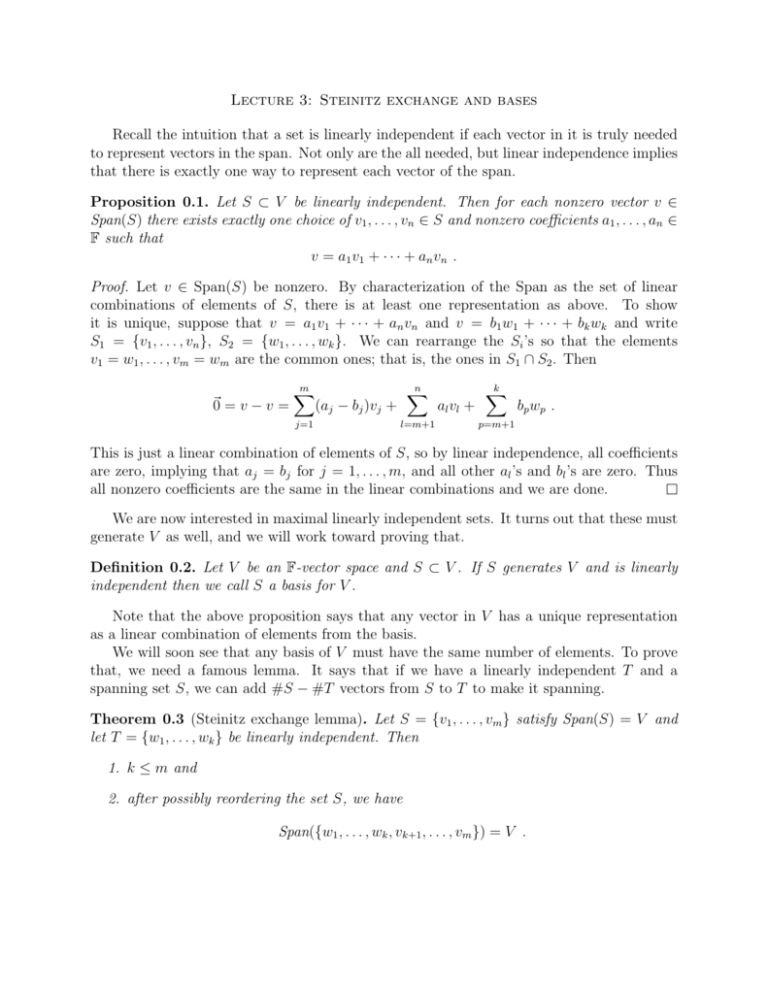
Lecture 3: Steinitz exchange and bases
Recall the intuition that a set is linearly independent if each vector in it is truly needed
to represent vectors in the span. Not only are the all needed, but linear independence implies
that there is exactly one way to represent each vector of the span.
Proposition 0.1. Let S ⊂ V be linearly independent. Then for each nonzero vector v ∈
Span(S) there exists exactly one choice of v1 , . . . , vn ∈ S and nonzero coefficients a1 , . . . , an ∈
F such that
v = a1 v1 + · · · + an vn .
Proof. Let v ∈ Span(S) be nonzero. By characterization of the Span as the set of linear
combinations of elements of S, there is at least one representation as above. To show
it is unique, suppose that v = a1 v1 + · · · + an vn and v = b1 w1 + · · · + bk wk and write
S1 = {v1 , . . . , vn }, S2 = {w1 , . . . , wk }. We can rearrange the Si ’s so that the elements
v1 = w1 , . . . , vm = wm are the common ones; that is, the ones in S1 ∩ S2 . Then
~0 = v − v =
m
X
j=1
n
X
(aj − bj )vj +
l=m+1
al vl +
k
X
bp w p .
p=m+1
This is just a linear combination of elements of S, so by linear independence, all coefficients
are zero, implying that aj = bj for j = 1, . . . , m, and all other al ’s and bl ’s are zero. Thus
all nonzero coefficients are the same in the linear combinations and we are done.
We are now interested in maximal linearly independent sets. It turns out that these must
generate V as well, and we will work toward proving that.
Definition 0.2. Let V be an F-vector space and S ⊂ V . If S generates V and is linearly
independent then we call S a basis for V .
Note that the above proposition says that any vector in V has a unique representation
as a linear combination of elements from the basis.
We will soon see that any basis of V must have the same number of elements. To prove
that, we need a famous lemma. It says that if we have a linearly independent T and a
spanning set S, we can add #S − #T vectors from S to T to make it spanning.
Theorem 0.3 (Steinitz exchange lemma). Let S = {v1 , . . . , vm } satisfy Span(S) = V and
let T = {w1 , . . . , wk } be linearly independent. Then
1. k ≤ m and
2. after possibly reordering the set S, we have
Span({w1 , . . . , wk , vk+1 , . . . , vm }) = V .
Proof. The proof is by induction on k, the size of T . If k = 0 then T is empty and thus
linearly independent. In this case, we do not exchange any elements of T with elements of
S and the lemma simply states that 0 ≤ m and Span(S) = V , which is true.
Suppose that for some k ≥ 0 and all linearly independent sets T of size k, the lemma
holds; we will prove it holds for k + 1, so let T = {w1 , . . . , wk+1 } be a linearly independent
set of size k + 1. By last lecture, {w1 , . . . , wk } is linearly independent and by induction,
k ≤ m and we can reorder S so that
Span({w1 , . . . , wk , vk+1 , . . . , vm }) = V .
Because of this we can find scalars a1 , . . . , am such that
a1 w1 + · · · + ak wk + ak+1 vk+1 + · · · + am vm = wk+1 .
(1)
If k = m or if k ≤ m − 1 but all the coefficients ak+1 , . . . , am are zero, then we have
wk+1 ∈ Span({w1 , . . . , wk }), a contradiction since T is linearly independent. Therefore we
must have k + 1 ≤ m and at least one of ak+1 , . . . , am must be nonzero. Reorder the set S
so that ak+1 6= 0. Then we can solve for vk+1 in (1) to find
vk+1 ∈ Span({w1 , . . . , wk+1 , vk+2 , . . . , vm }) .
Therefore each element of {w1 , . . . , wk , vk+1 , . . . , vm } can be represented as a linear combination of elements from {w1 , . . . , wk+1 , vk+2 , . . . , vm }, and since the former set spans V , we
see that
Span({w1 , . . . , wk+1 , vk+2 , . . . , vm }) = V .
This completes the proof.
We can now give all the consequences of this theorem.
Corollary 0.4. Let V be an F-vector space. If B1 and B2 are both bases for V then they
have the same number of elements.
Proof. If B1 is finite, with n elements, then suppose that B2 has at least n + 1 elements.
Choosing any such subset of size n + 1 as T and B1 as the spanning set from the previous
theorem, we see that n + 1 ≤ n, a contradiction. This means #B2 ≤ #B1 . If on the
other hand B1 is infinite, then if B2 were finite, we could reverse the roles of B2 and B1 ,
apply Steinitz again, and see #B1 ≤ #B2 , a contradiction. Therefore in all cases we have
#B2 ≤ #B1 . Applying this same logic for B1 and B2 reversed, we get #B1 ≤ #B2 , proving
the corollary.
Definition 0.5. A vector space with a basis of size n is called n-dimensional and we write
dim(V ) = n. If this is true for some n we say the vector space is finite dimensional. Otherwise we say that V is infinite dimensional and write dim(V ) = ∞.
Note that {~0} is zero dimensional, since ∅ is a basis for it.
2
Corollary 0.6. Let V be an n-dimensional vector space (n ≥ 1) and S = {v1 , . . . , vm }.
1. If m < n then S cannot span V .
2. If m > n then S cannot be linearly independent.
3. If m = n then S is linearly independent if and only if it spans V .
Proof. Let B be a basis for V . Then using Steinitz with B as the linearly independent set
and S as the spanning set, we see that if S spans V then S has at least n elements, proving
the first part. Similarly, using Steinitz with B as the spanning set and S as the linearly
independent set, we get part two.
If m = n and S is linearly independent then Steinitz implies that we can add 0 vectors
from B to S to make S span V . This means S itself spans V . Conversely, if S spans V ,
then if it is not linearly independent, we can find v ∈ V such that v ∈ Span(S \ {v}), or
V = Span(S) ⊂ Span(S \ {v}). Therefore S \ {v} is a smaller spanning set, contradicting
the first part.
Corollary 0.7. If W is a subspace of V then dim(W ) ≤ dim(V ). In particular, if V has a
finite basis, so does W .
Proof. If V is infinite dimensional there is nothing to prove, so let B be a finite basis for V
of size n. Consider all subsets of W that are linearly independent. By the previous corollary,
none of these have more than n elements (they cannot be infinite either since we could then
extract a linearly independent subset of size n + 1). Choose any one with them largest
number of elements and call it BW . It must be a basis – the reason is that it is a maximal
linearly independent subset of W (this is an exercise on this week’s homework). Because it
has no more than dim(V ) number of elements, we are done.
3
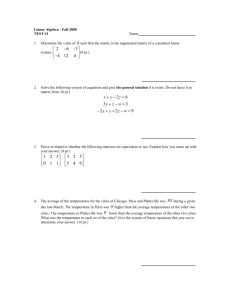
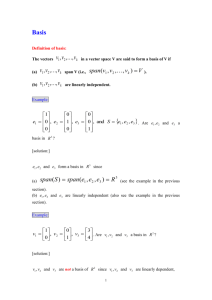
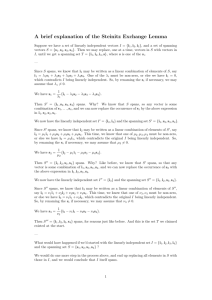
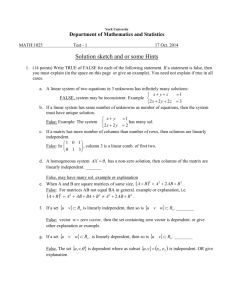



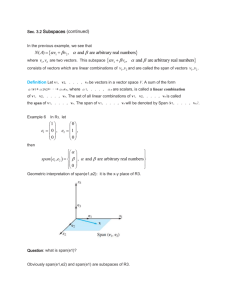
![2010Fall-LA-Lecture-13[1]](http://s3.studylib.net/store/data/006762182_1-3901e79b726aad1cc0b426785aced7c7-300x300.png)
